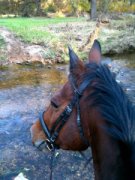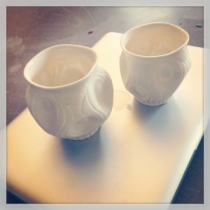My friend Joe told me a story recently about sparkles.
He was sitting on a tree trunk that extended into the stream at a nearby nature preserve where we sometimes hike.
On this sunny morning, he was relaxed, loosening his mind and listening to the soft trickle of water over stones and the fall breeze. His hand fell open, and he noticed the sparkles from the water hitting his hand, almost like he could catch them there. He watched in wonder.
Joe told me that he realized that those sparkles were not really there on his hand. What he was seeing was reflected and refracted light that was always there on such a sunny morning. If he was not there, the sparkles would be hitting the trees or the grass on the stream banks, unnoticed. And even while he was present to notice such beauty, it took the scientific, biological process of his vision to call the reflections to mind. Light rays struck his retina, and were further processed by systems we learned about in high school biology class, in order that he could perceive sparkles in his hand as beauty.
The beauty didn’t just happen. It took his active presence and participation for it to exist.
Joe’s story has been a quiet meditation for me over the last week of teaching. I have been thinking a lot about the value of presence – of showing up fully for my classes and my students.
It’s not as easy as it might sound. If there has been one theme of this school year for me, it has been competing priorities. Professionally, I am teaching a two-course overload, advising three co-curricular activities (and trying to do these very well), attempting to do independent professional development work that will renew my certification, reading whatever might help me to stay current and articulate about proposed changes to education, and trying to practice as an artist when I can. Although the personal load should be irrelevant to my career, I will just note that it exists and also has some volume. When I run into the studio to teach each class this year, I feel (and often am) out of breath and moving too fast, shoulders a little sore from carrying this load.
My students mirror my frenetic pace. They carry just as much – sometimes literally, I notice, as I try to move a pile of impossibly heavy backpacks away from another classroom door. My time is divided between two general subject areas – ceramics and graphic design. Theirs is stretched by six, seven, eight, or even more if you count athletics. When I get to know them well enough to understand their personal loads, I am often stunned by the weight of family and personal issues they carry. When we all land in a studio together for 45 minutes, I sometimes wonder whether this time would be better served by deep breathing and meditation than by trying to make pots.
But we do make pots, and we share experiences. And I’ve been wondering if the most important thing I can do is be fully present, to catch and reflect the sparkles when they happen.
Last Friday, after a field trip to a craft exhibit, I was exhausted by the time our bus returned to campus – and facing another four hours of work for an evening event. We had seen some amazing things at the show, and I was looking forward to processing them with my students… on Monday, after I’d caught up on rest and energy. After cleaning off the bus and wrapping up the paperwork, I got back to the studio to find several students waiting for me. This was around 4:30 PM. They had already brewed tea. I asked them about their experience at the exhibit, and quickly forgot my exhaustion as I listened to their impressions. Without knowing it, one student and I had purchased similar cups from an artist. We compared the subtly different forms, and discussed rationale in our selections. Another student had already developed sketches for his next project based on what he’d seen, and wanted to review them. With a thoughtful twinkle in his eyes, Dan shared an interaction with one artist who told him, “The most difficult thing to learn to be in this world is yourself.”
By Monday, these experiences would have dulled. By showing up, I caught the shiny moments, and reflected their value.
On Wednesday after school, one student’s teapot fell apart. He had been walking the delicate line of drying. Dry enough to trim as thoroughly as he likes is just a bit too dry to attach spouts and handles. Clay teaches this better than I can, and so I watched as he tried, failed, and learned from his attempt. I could tell that he was disappointed and frustrated – clay teaches this, too, but these are tough lessons when there is a portfolio timeline. He wedged 25 pounds of groggy red clay, put his headphones on, and got to work centering the massive mound. I sat at the table, updating my online gradebooks and responding to the day’s emails.
When I saw him wrestling with the clay, I closed my laptop and wedged my own 25-pound lump. It’s been a long time since I’ve centered this much clay, but I sat at a wheel across from him and got to work in solidarity. You can’t explain – well, I can’t explain – how to brace your arm or angle your wrist to work with clay like this. You have to show, and to do alongside. We figured out where the problem was with his cylinder, and he fixed it as best he could. I ended up standing to throw my own piece – it had been so long since I’d done this, and the strain in my neck and back felt good, more real than the cramps from typing at a small screen. We stood back from our pieces, silently deciding what to do next with the large red and white pots.
I won’t spoil what he decided to do to his piece – it’s his to share – but suffice to say I’m excited about his solution, and I can’t wait to see what happens in the next few steps.
As for mine, I think it’s a whole lot more interesting after I let him kick it. It happened to be a pretty thoughtful and well-considered kick.
We stood back from the pieces again. We laughed at his red, stinging foot. “Thanks,” he said. “After that teapot – after today – I needed that.”
And the sparkles landed in my palm.
–
I worry about being so busy that I miss moments like this. I am the person I have become because I was lucky enough to have some teachers and mentors who modeled active presence and participation – a sort of radical connection – in my life. Now, I know that they were probably equally as busy and overloaded as I feel these days. But they made the time and space for individual, personal connections that made all the difference.
One of those mentors often reminded me, “We have a finite amount of time and energy. And we have choices on how we spend it.” Few words have stuck with me so much. In my finite world as a teacher, I want to make the choice to hold the sparkles in my hand as often as I can.








